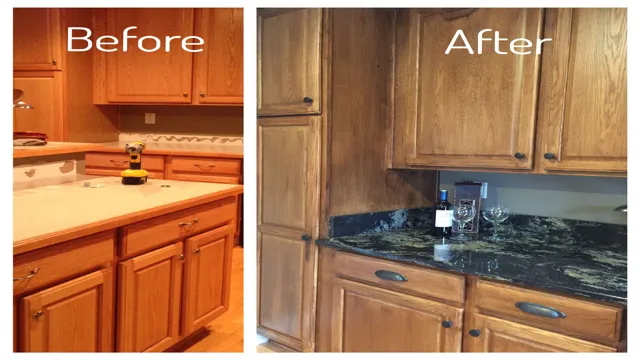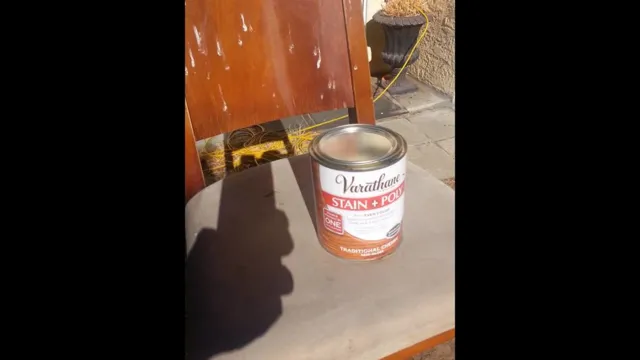So, you’ve invested your time and effort in staining your woodwork, and the results are stunning. But wait, you’re not quite done yet! Applying a protective cover of polyurethane is essential to ensure that your woodwork stays beautiful for years to come. However, the question that plagues most wood enthusiasts is, “When to apply polyurethane after staining?” Applying polyurethane too soon or too late can ruin all of your hard work.
In this blog post, we’ll explore all of the essential aspects of polyurethane application that ensure a perfect finish every time.
Understanding Stain Drying Time
Asking how long after stain can I poly is a common question when it comes to finishing a wood project. The answer varies depending on the type of stain, humidity, temperature, and whether you used oil-based or water-based products. Generally, oil-based stains take longer to dry than water-based stains.
It’s best to wait 24-48 hours before applying polyurethane on top of a stain. If the weather is humid or cooler than normal, it may take longer to dry. Rushing the process and applying poly too soon can result in a cloudy or tacky finish.
It’s essential to check the manufacturer’s instructions on both the stain and the polyurethane products you are using to ensure the best results. Taking the time to follow the guidelines will save you time and money in the long run by creating a beautiful, durable finish on your wood project.
Factors Affecting Stain Drying Time
Stain drying time can be affected by a variety of factors, including the type of stain, humidity levels, temperature, and airflow. For example, oil-based stains generally take longer to dry than water-based stains because they have a higher viscosity. Humidity levels can also play a role in drying time, as higher moisture levels in the air can cause stains to dry more slowly.
Temperature can also affect staining drying time, with warmer temperatures generally leading to faster drying times. Finally, the amount of airflow in the room can impact drying time, as increased air movement can speed up the process. Understanding these factors is important for achieving optimal results when staining wood or other materials.
So, the next time you plan to take up a staining project, consider these factors to ensure you get the best results possible.

Types of Stain and their Drying Times
When it comes to staining your furniture or floors, it’s crucial to understand the different types of stains and their drying times. Generally, there are two types of stains: oil-based and water-based. Oil-based stains take longer to dry and penetrate into the wood’s surface, resulting in rich and deep colors.
They can take anywhere from 8 to 24 hours to dry, depending on temperature and humidity. On the other hand, water-based stains dry quickly, are more environmentally friendly, and are ideal for DIY projects. They usually dry in around 2-3 hours, which makes them ideal for those who want a quick and easy staining process.
It’s essential to note that drying time can be affected by the type of wood, the amount of stain used, and the temperature and humidity of your environment. Knowing the type of stain you’re working with will help you plan accordingly and ensure that you get the desired results.
Polyurethane Application Timeframe
If you’ve recently stained a wooden surface and are wondering when you can apply polyurethane, the answer is that it depends on a few factors. Firstly, it’s essential to wait until the stain has fully dried before beginning the polyurethane application process. This typically takes between 24-48 hours, but can sometimes take longer depending on the temperature and humidity of your environment.
Additionally, the type of stain and polyurethane you’re using may affect your timeline. Water-based polyurethane can typically be applied sooner after staining compared to oil-based polyurethane. For best results, it’s recommended to read the product labels carefully and follow the manufacturer’s suggested wait time before applying polyurethane.
Rushing the process can result in uneven results or damage to the newly stained surface. So, take your time and ensure that the wooden surface is fully ready before proceeding with the polyurethane application.
Timing Considerations for Polyurethane Application
When it comes to polyurethane application, timing is everything. Applying polyurethane at the right time is crucial for ensuring that it adheres properly to the surface and provides a long-lasting finish. The ideal time to apply polyurethane varies depending on the specific type of product being used and the environmental conditions.
For instance, polyurethane should be applied when the temperature is between 60 and 80 degrees Fahrenheit and the humidity is below 50%. Additionally, waiting for the appropriate amount of drying time between coats is important for achieving a smooth finish. Rushing the process can lead to uneven coats or a tacky finish.
In short, taking the time to apply polyurethane correctly can make a big difference in the overall quality and durability of the final product.
Effects of Applying Polyurethane Too Soon
When it comes to applying polyurethane, it’s important to make sure you follow the recommended timeframe. Applying polyurethane too soon can have negative effects on the final result. If you apply polyurethane before the previous coat fully dries, it can cause bubbling, peeling, or cracking.
It’s essential to allow each coat of polyurethane to dry thoroughly before applying the next one. Rushing the process can lead to an unprofessional finish and potentially ruin the project. In summary, it’s important to follow the recommended timeframe for polyurethane application to ensure a high-quality and long-lasting result.
Effects of Waiting Too Long to Apply Polyurethane
Polyurethane Applying polyurethane to a surface is an important step for enhancing its longevity and durability. However, waiting too long to apply polyurethane can have negative effects. If not applied within a reasonable time frame, the surface can become susceptible to scratches, dings, and other damages.
Moreover, the surface may start to lose its shine and luster, making it look dull and old. This is because polyurethane acts as a protective layer that seals the surface and prevents it from damage due to external factors like moisture, abrasion, and UV rays. Therefore, it is always recommended to apply polyurethane within the specified time frame to ensure the best results.
Waiting too long can lead to unnecessary expenses and the need for additional repairs and maintenance. So, be sure to follow the manufacturer’s instructions and apply polyurethane promptly to protect your surface and maintain its beauty.
Conclusion
In conclusion, the question of how long after staining can one apply polyurethane is a bit like asking how long after a first date can you propose marriage. While there is no hard and fast rule, it’s generally recommended to give the stain ample time to dry and settle before jumping into a long-term commitment with polyurethane. So, be patient, take your time, and enjoy the process of watching your project blossom into a thing of beauty before sealing the deal with a coat of poly!”
FAQs
How long should I wait after staining before applying polyurethane?
It’s recommended to wait at least 24 hours after staining before applying polyurethane to ensure the stain is fully dried and cured.
Can I apply polyurethane directly over a freshly stained surface?
No, it’s important to wait for the stain to fully dry and cure before applying polyurethane to ensure a smooth finish.
What happens if I apply polyurethane too soon after staining?
Applying polyurethane too soon can cause the stain to smear or bleed, resulting in an uneven finish.
Can I apply multiple coats of polyurethane after the first coat has dried?
Yes, it’s recommended to apply multiple thin coats of polyurethane to ensure a durable and long-lasting finish.
How long should I wait between coats of polyurethane?
It’s recommended to wait at least 2-4 hours between coats of polyurethane to allow sufficient drying time.
Should I sand between coats of polyurethane?
Yes, lightly sanding between coats can help to ensure a smooth and even finish.
Can I use a foam brush to apply polyurethane?
Yes, foam brushes can be used to apply polyurethane, but a natural bristle brush is recommended for the best finish.






